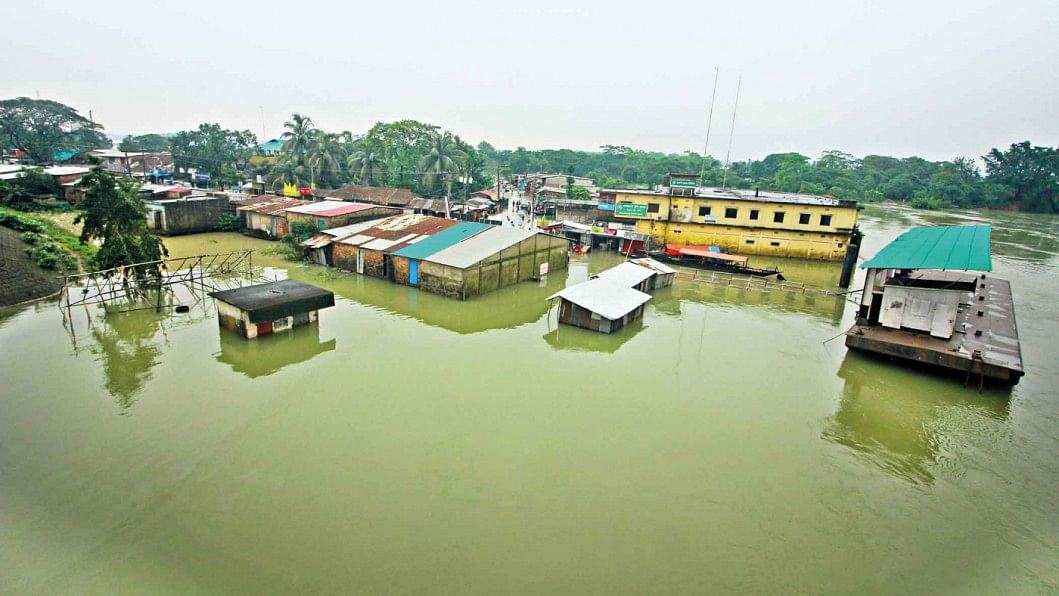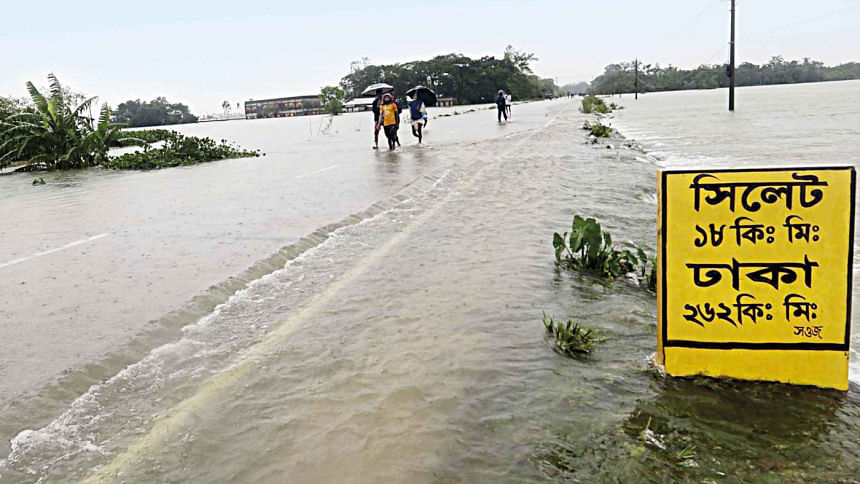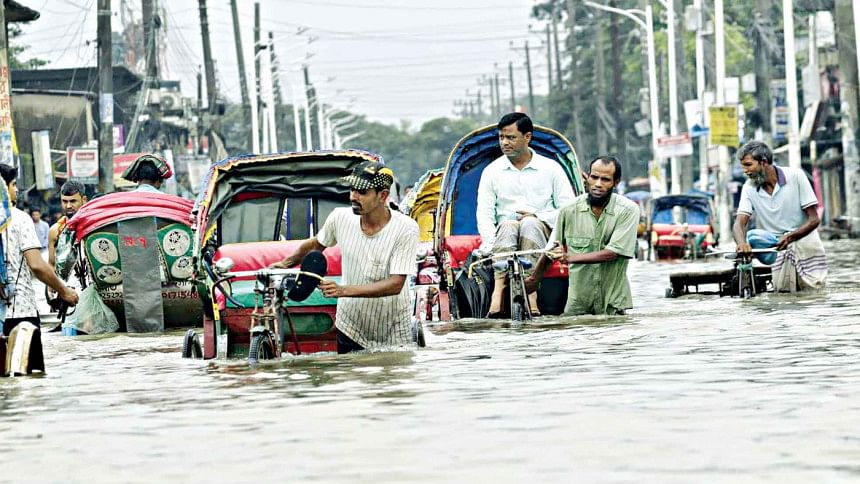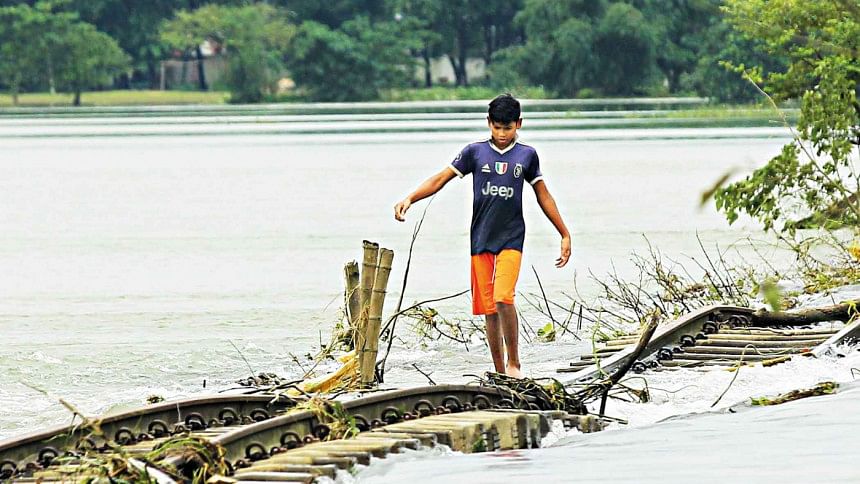Nature’s revenge

For around a month now, all four districts in the Sylhet division have been enduring floods with the water receding slowly from many areas and thousands left to suffer.
About 45 thousand people in the division are still in 662 shelter centres as of Wednesday, and the Eid, needless to say, brought no joy for them.
"My home is still submerged and I am living in the shelter centre with my family. For weeks, I have got no work and don't know how to repair my damaged home. Our Eid joy has been washed away by the floodwater," said Abdur Noor of Jabda village in Moulvibazar's Kulaura upazila.
Strong currents of floodwater have damaged around 1 lakh houses while more than 63 lakh people are affected and still in distress.

Rozina Begum, of Bashkala village in Sunamganj's Chhatak, said, "The flood washed away my home, and now I am living on a culvert with my family. We cannot afford to rebuild it and don't know how to return to the life we had before."
But why did such a devastating flood strike the region?
"We have seen both Bangladesh and upstream states of Meghalaya and Assam and western Himalayan regions of India recording heavy rainfalls, the highest in over 100 years," said Prof AKM Saiful Islam of Institute of Water and Flood Management at Buet.
Major rivers and their tributaries in Bangladesh have no capacity to contain such a huge volume of rainwater, which caused massive flooding in north-eastern and northern regions of the country, he added.
Experts observed that the only exit point for the floodwater, the Meghna river at Bhairab, also lacks the capacity to allow such a huge volume of floodwater to pass.
Dr Ainun Nishat, professor emeritus at Brac University, said, "The water flow of the Surma is obstructed near Bhairab, where the river is called the Kalni. For the last few years, even vessels cannot operate in the river during the lean period."
Sharif Jamil, general secretary of Bangladesh Paribesh Andolon, said the construction of three bridges have created a bottleneck at Bhairab. "So, the water coming down from upstream is receding slowly."

The entire haor region is comprised of 373 haors spreading across 8,58,460 hectares of area, or 8,584.6 sq km, in seven districts -- Sunamganj, Sylhet, Habiganj, Moulvibazar, Netrokona, Kishoreganj and Brahmanbaria.
Vast stretches of haor area remain submerged for roughly 6-7 months of the year during the monsoon.
Dr Adil Mohammed Khan, executive director of Bangladesh Institute of Planners said, "The flood took a serious turn during this monsoon as the water retaining capacity of the haor region has been reduced significantly."
Recently Dr Adil presented a study report at a seminar that reveals most of the water bodies in 373 haors -- which used to have water in dry season -- got filled up due to natural causes or human activities.
Based on satellite images, the study found that the haor area lost almost 40 percent of dry season wetlands from 1988 to 2006. The rate of changing wetland into built-up areas was even faster and filling up of some waterbodies reached up to 87 percent by 2020.
Two Buet graduates, Injamumul Haque Refat and Maria Mehrin, conducted the study on land cover changes in haors of Bangladesh analysing satellite images taken in 1988, 1994, 2000, 2006, 2013 and 2020 of 373 haors.
"While analysing satellite images, we found that in 1988, there were waterbodies across around 3,100 sq km in the dry season but the area was only 399 sq km in 2020," said Refat.
"We have found different concrete structures including roads, houses and other establishments in those areas," he added.

What locals say also supports their findings.
Kawsar Ahmed, a boatman of Bashtala village in Chhatak, said, "They constructed a road to connect Chhatak and Dowarabazar upazilas right through the haor. It was awaiting inauguration but the floodwater washed away it in several places."
Meanwhile, the landslides on open-cast mines and the razing of hillocks in India's Meghalaya led to filling up of rivers, creeks and haors.
For example, Pochashol Beel of Tanguar Haor in Sunamganj has been filled up in recent years due to the landslides in the Meghalaya hills, locals claimed.
In the last year alone, at least 400 acres of land, mostly farmland, has been covered with sand, said bordering locals of Tahirpur upazila in Sunamganj.

Indigenous rights leader Andrew Sholomar, a resident of Rajai village in the upazila, said: "Visiting the hills in Meghalaya, I saw mining of stone, limestone and coal going on, causing landslides there."
Sharif Jamil, general secretary of Bangladesh Poribesh Andolon, said, "As a result of the mining in Meghalaya, the ecosystem of haor is being severely impacted. Even the uranium mining there is also affecting the haors. This must be stopped through bilateral talks."
"Moreover," he added, "a modern framework is necessary to manage all the transboundary rivers of Ganga, Brahmaputra and Meghna basins when the Joint Rivers Commission is failing."



 For all latest news, follow The Daily Star's Google News channel.
For all latest news, follow The Daily Star's Google News channel. 



Comments